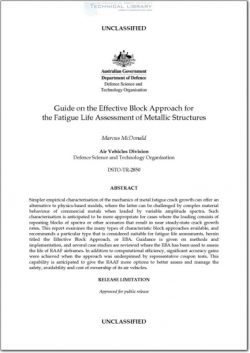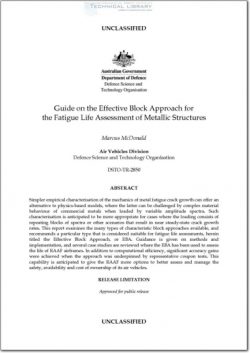DSTO-TR-2850

- Version
- 126 Downloads
- 1.96 MB File Size
- 1 File Count
- August 10, 2016 Create Date
- August 10, 2016 Last Updated
Guide on the Effective Block Approach for the Fatigue Life Assessment of Metallic Structures

Most RAAF aircraft are life-limited due to the metal fatigue failure mode. Predictive
modelling is necessary for effective structural integrity management of these life limits.
Mechanistic type approaches that attempt to model the physical and chemical
behaviour of the metal fatigue mechanism can be difficult to develop to a sufficient
level of reliability in a given timeframe. Variable amplitude loadings that cause
retardation/ acceleration effects are particularly difficult to simulate. This can
significantly restrict the RAAF’s options available for managing the structural integrity
of its air vehicles. However, if the variable amplitude loading consists of regularly
repeating blocks, or otherwise is considered to produce steady—state crack growth
rates, then a characteristic block type modelling approach may offer an alternate path
for conducting life assessments. This is anticipated to be particularly useful for full—
scale test interpretation where the applied loading usually consists of repeating
spectrum blocks.
Characteristic block type approaches consider the average crack growth rates for a
spectrum block, and characterise these against the predominant influential parameters
(6.3., crack size, stress or stress intensity factor). This report examines the many types of
characteristic block approaches described in the literature, and highlights that the
assumptions and efficacy of each can vary significantly. Guidance is given on
distinguishing amongst them, and a recommendation is given for a particular type that
is considered suitable for conducting fatigue life assessments, herein titled the Effective
Block Approach, or EBA. This guide provides steps for using an EBA; considers the
benefits and limitations; and reviews a number of case studies. It was found that, when
the crack growth rates are underpinned by representative fatigue tests, an EBA can
provide significant accuracy, efficiency and insights toward prediction of metal fatigue
crack growth.
DSTO has significant full-scale, component and coupon test facilities that it uses to
assess RAAF airframes. The efficient and accurate modelling of crack growth is a
necessary capability for translating the test outputs into relevant life results for
structural integrity management purposes. The EBA enables DSTO to continue to offer
leading structural integrity advice, even when mechanics—based models are still being
developed. Already, the EBA has been used to assess numerous airframes including
Macchi wings, F/A—18 Hornet centre barrels and F—111 wings. This capability is
anticipated to give the RAAF additional options to better assess and manage the safety,
availability and cost of ownership of its air vehicles.
| File | Action |
|---|---|
| DSTO-TR-2850 Guide on the Effective Block Approach for the Fatigue Life Assessment of Metallic Structures.pdf | Download |

Comment On This Post